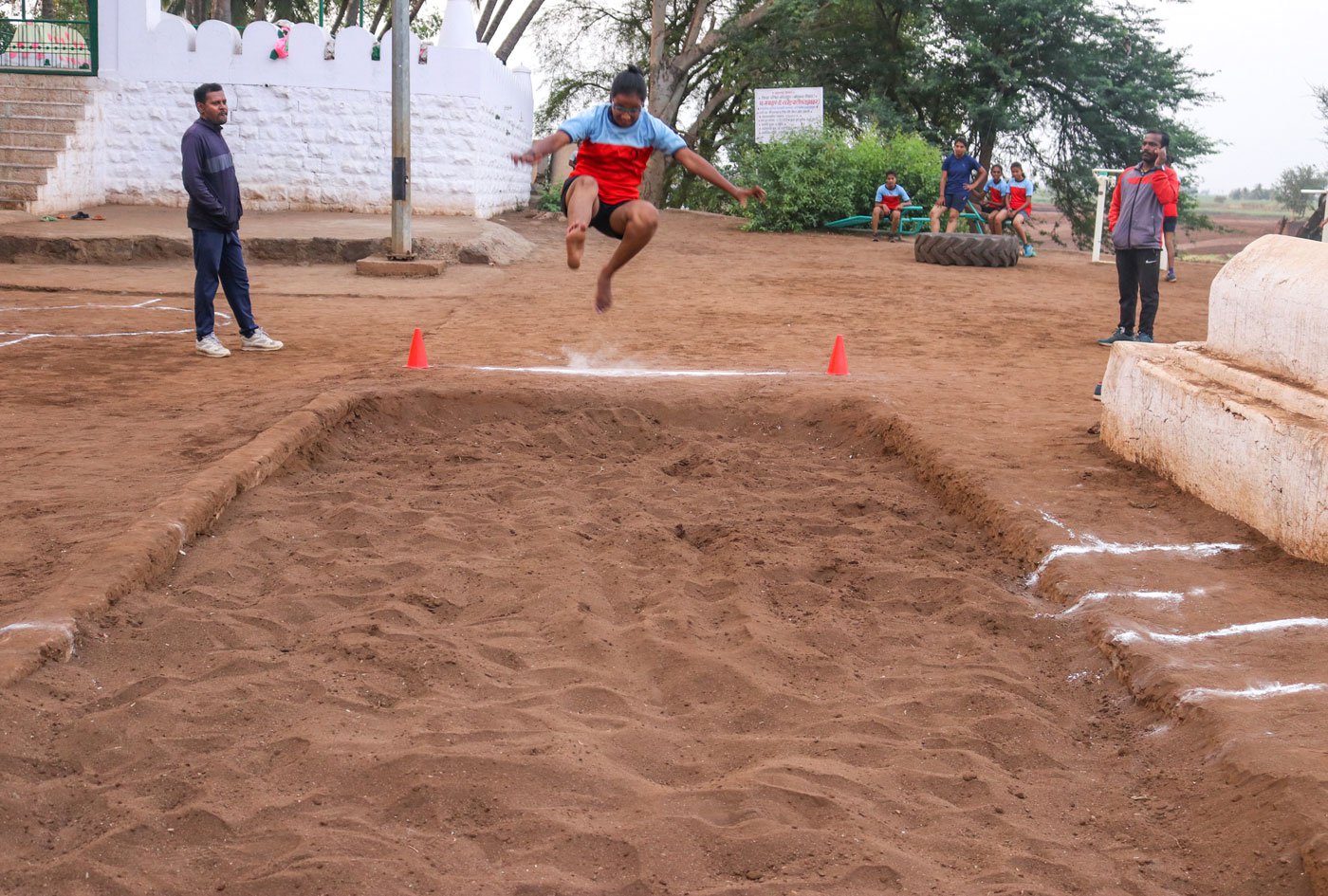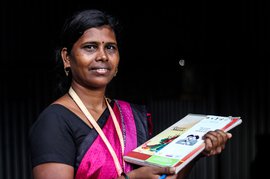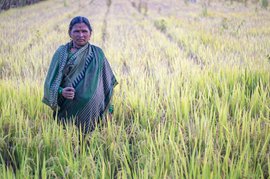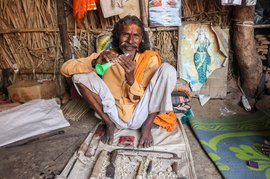For Saniya Mullani the first monsoon shower is always a reminder of a prophecy associated with the day of her birth.
She was born in July 2005, a week after the deadly floods that claimed over
1,000 lives
and affected 20 million people in Maharashtra. “She is born during the floods; she will spend most of her time in floods,” people are said to have told her parents.
Seventeen-year-old Saniya recalled this again when it started raining heavily in the first week of July 2022. “Whenever I hear
paani vaadhat challay
[The water level is rising], I fear there might be another flood,” says the resident of Bhendavade village in Hatkanangle
taluka
of Maharashtra's Kolhapur district. The village and its 4,686 residents have witnessed two devastating floods since 2019.
“During the floods of August 2019, the water rose to seven feet in our house within just 24 hours,” Saniya remembers. The Mullani family managed to escape just as water started entering their home, but the incident left Saniya with deep trauma.
Floods struck their village again in July 2021. This time, the family moved to a flood relief camp outside the village for three weeks, returning home only after it was deemed safe by village authorities.
A Taekwondo champion, Saniya’s training to become a black belt has suffered a setback ever since the 2019 floods. She has been experiencing fatigue, restlessness, irritability and increased anxiety for the past three years. “I cannot focus on my training,” she says. “My training is now dependent on the rain.”
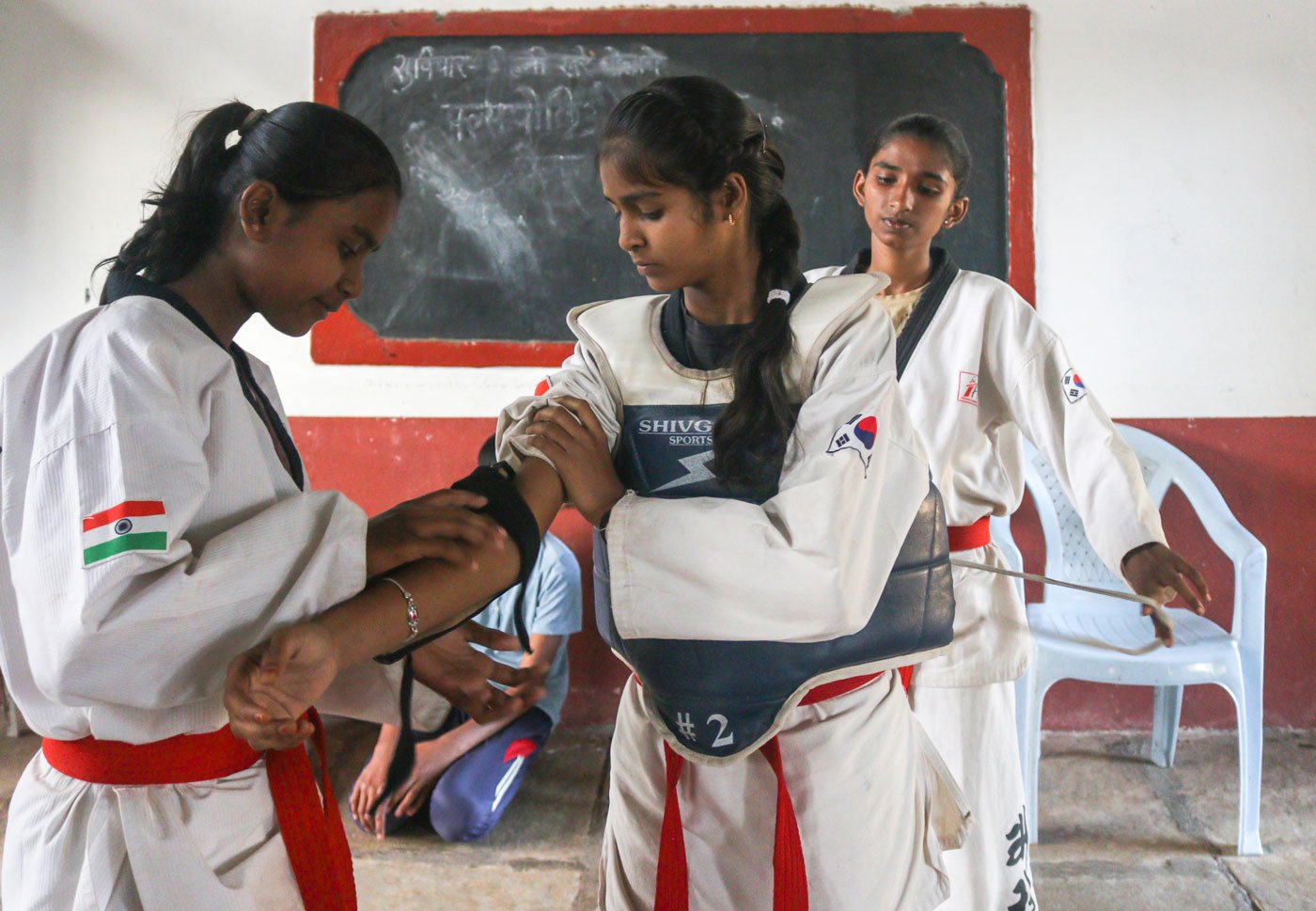
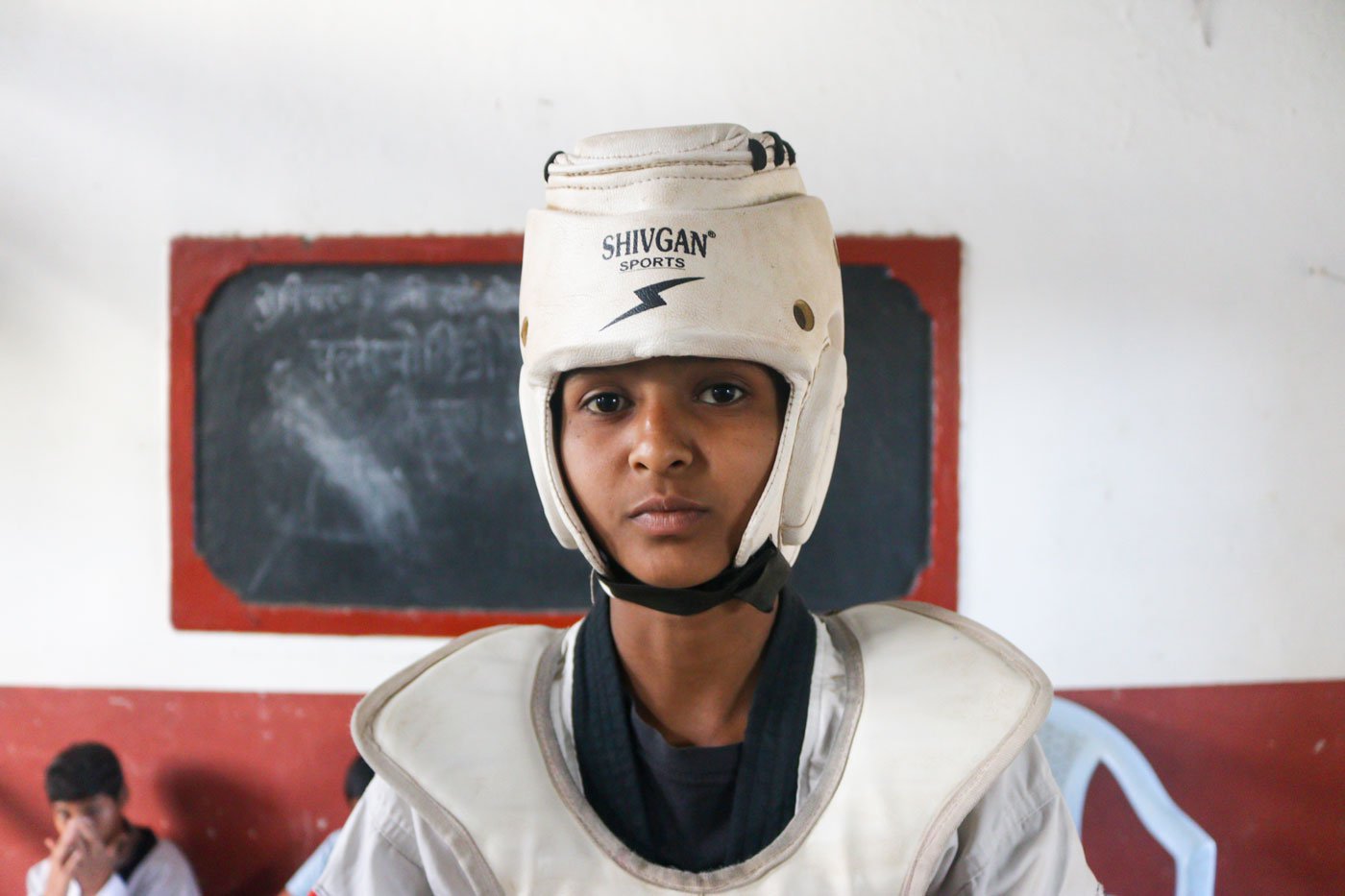
Left: Saniya Mullani (centre), 17, prepares for a Taekwondo training session in Kolhapur’s Bhendavade village. Right: The floods of 2019 and 2021, which devastated her village and her home, have left her deeply traumatised and unable to focus on her training
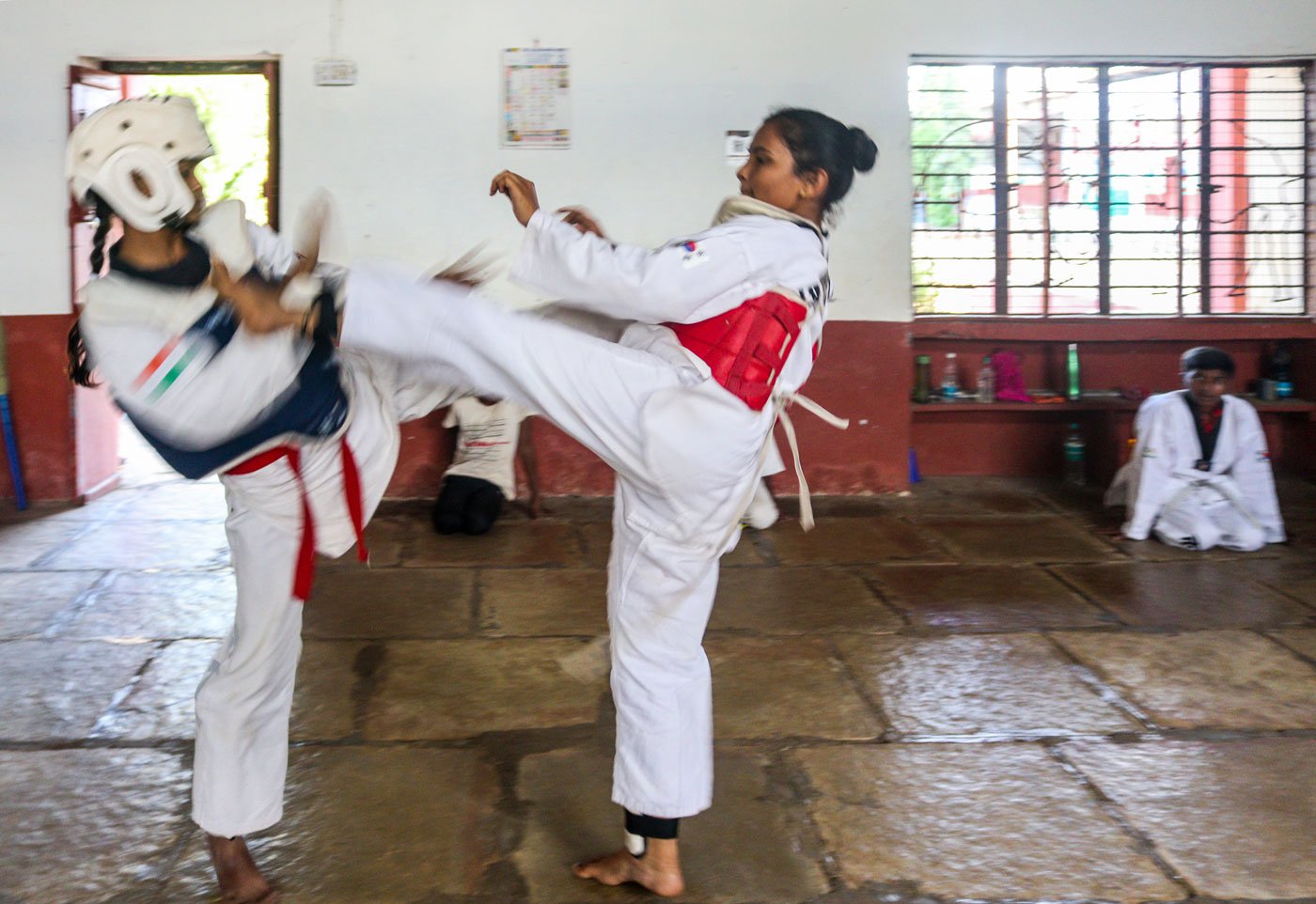
Young sportswomen from agrarian families are grappling with mental health issues linked to the various impacts of the climate crisis on their lives, including increased financial distress caused by crop loss, mounting debts, and lack of nutrition, among others
When the symptoms began, she thought she would get better with time. When that didn't happen, she consulted a private doctor. Since August 2019, she has visited the doctor at least 20 times, but dizziness, fatigue, body ache, recurring fever, inability to focus, and a constant feeling of “tension and stress,” refuse to go away.
“Now, even the thought of going to the doctor causes nightmares,” she says. “A private doctor charges at least 100 rupees for one visit; then there are costs for medicines, multiple tests and follow-ups,” she says. “In case there's a need for an intravenous drip, we have to shell out 500 rupees for every bottle.”
When the consultations failed to help, one of her friends gave her a solution: “
Gapp
training
karaycha
[Just go about your training, quietly].” That didn’t help either. To her frustration, when she spoke to her doctor about her deteriorating health, he simply told her, “Don't stress.” Perhaps the most difficult piece of advice for Saniya to follow, given the uncertainty around how the next spell of rain will behave and how her family will be impacted.
Saniya's father, Javed, who owns an acre of land, lost over 100,000 kilos of sugarcane during the 2019 and 2021 floods. Heavy rains and the Warna river in spate claimed most of his produce in 2022 too.
“Since the 2019 floods, there is no guarantee that you will reap the fruits of what you sow. Every farmer here has to sow at least twice,” says Javed. This roughly doubles the cost of production, while the returns are sometimes naught, making farming unsustainable.
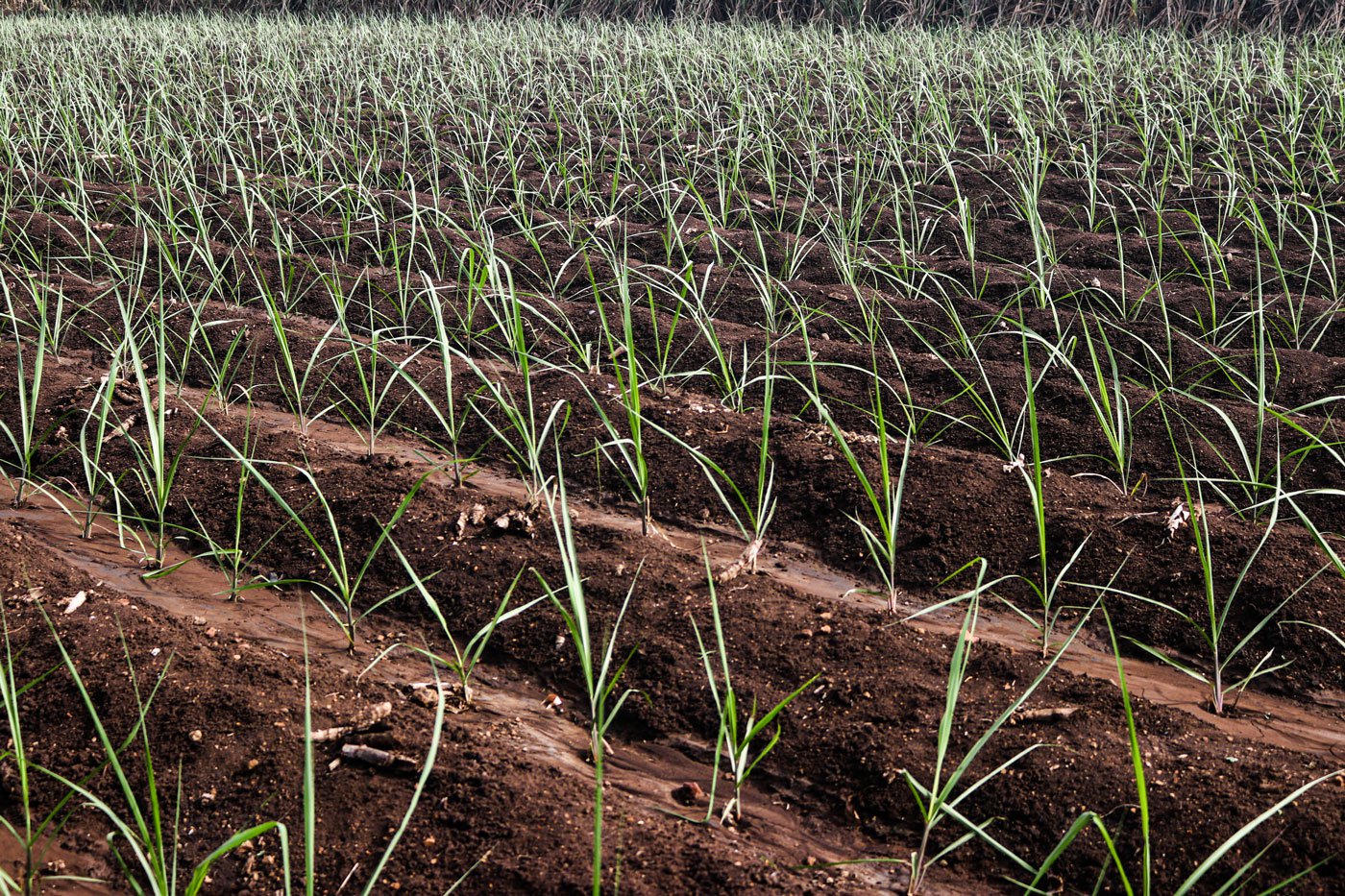
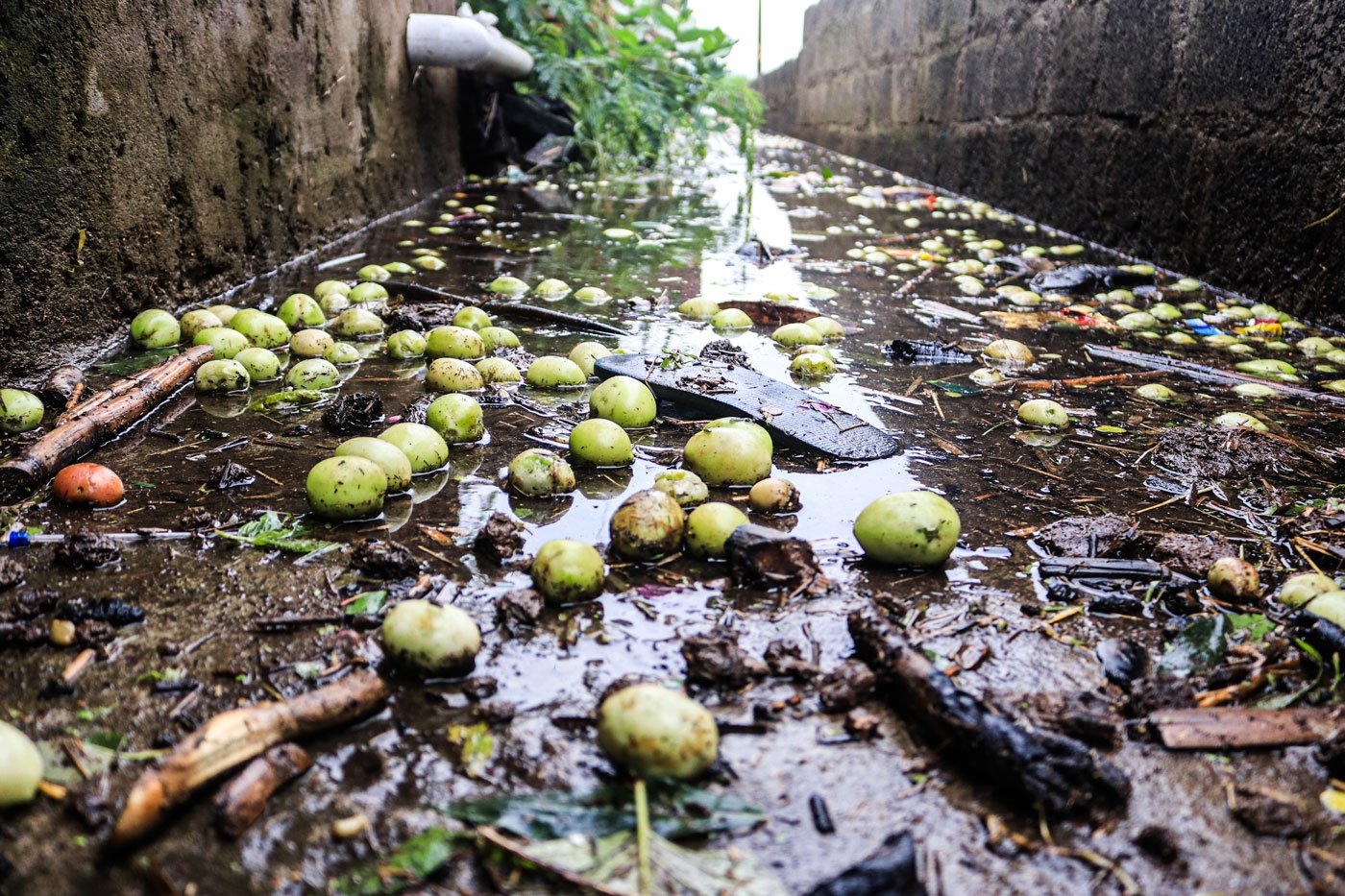
The floods of 2019 destroyed sugarcane fields (left) and harvested tomatoes (right) in Khochi, a village adjacent to Bhendavade in Kolhapur district
The only way out is to borrow from private moneylenders at exorbitant interest rates, compounding the stress. “As the monthly repayment date approaches, you will see several people running to the hospital because of stress,” Saniya adds.
Mounting debt and the fear of another flood leave Saniya anxious most of the time.
“Usually, after any natural disaster, people are not able to put in the desired efforts to achieve their goals. It’s not because they don't want to; they are unable to,” says Kolhapur-based clinical psychologist Shalmali Ranmale Kakade. “This eventually leads to helplessness, frustration, and several sad emotions, which start affecting their mood and lead to anxiety.”
The UN Intergovernmental Panel on Climate Change (IPCC) has for the first time highlighted that
climate change severely affects
the mental health of people: “Mental health challenges, including anxiety and stress, are expected to increase under further global warming in all assessed regions, particularly for children, adolescents, elderly, and those with underlying health conditions.”
*****
Aishwarya Birajdar, 18, saw her dreams swept away by the floods of 2021.
After the water receded, the sprinter and Taekwondo champion from Bhendavade spent over 100 hours across 15 days cleaning her house. “The stench just wouldn't go; the walls looked as if they could collapse anytime,” she says.
It took around 45 days for life to regain some sense of normalcy. “If you skip a day's training, you don't feel good,” she explains. Making up for 45 days of lost training meant she had to work harder. “[But] My stamina has fallen drastically because we are supposed to train double while eating half the food. This is unsustainable and causes a lot of tension,” she says.
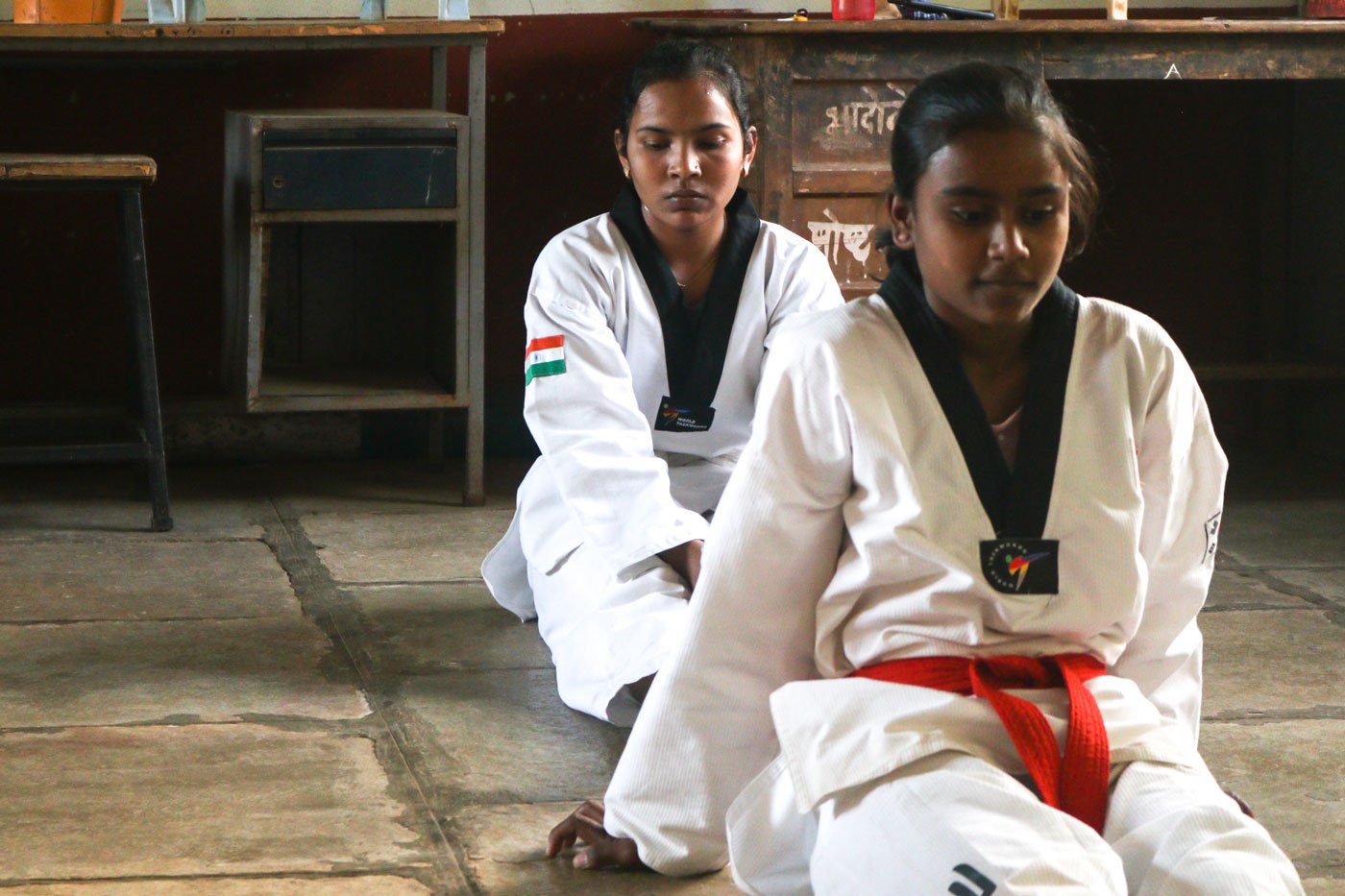
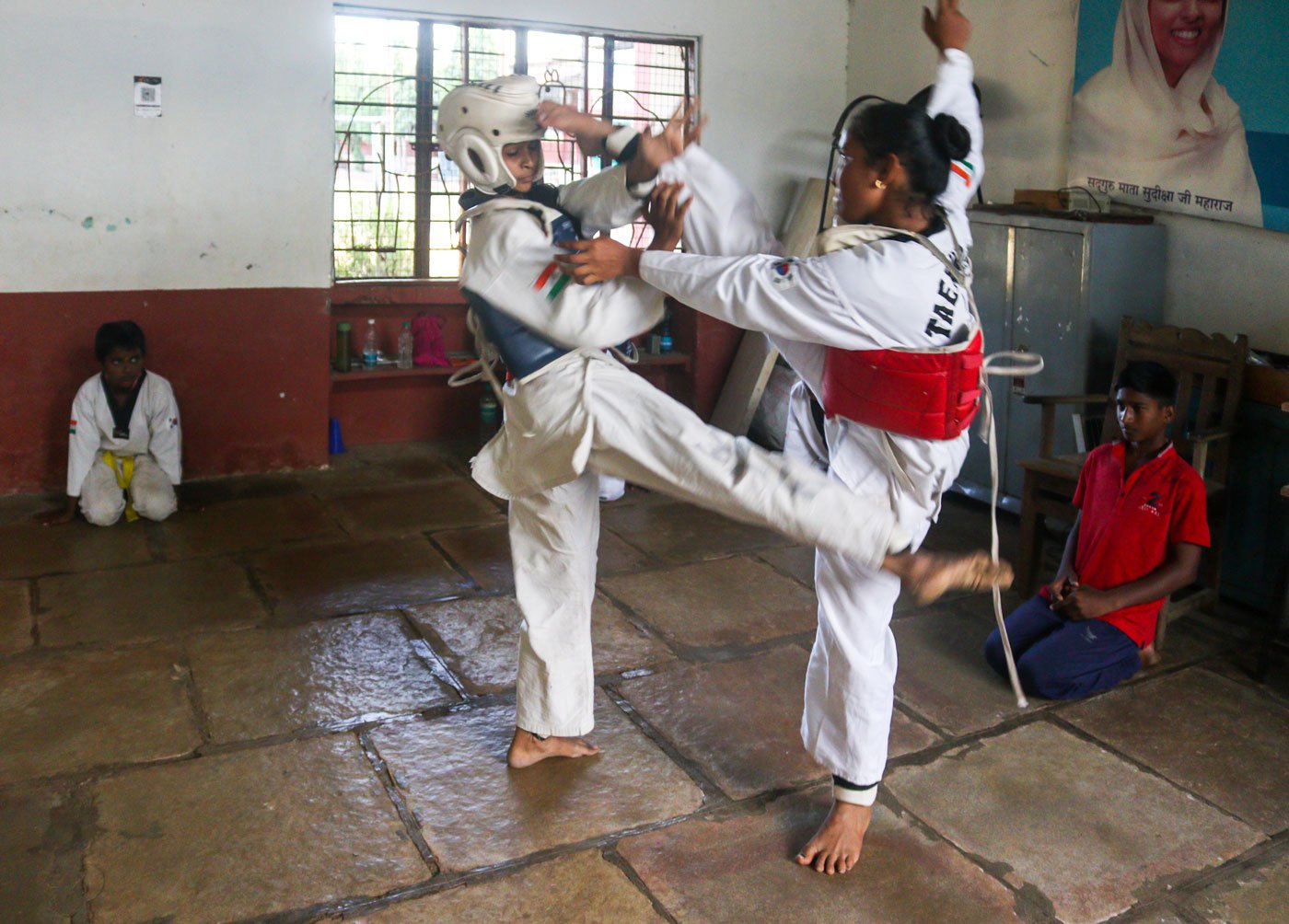
Sprinter and Taekwondo champion Aishwarya Birajdar (seated behind in the first photo) started experiencing heightened anxiety after the floods of 2021. She often skips her training sessions to help her family with chores on the farm and frequently makes do with one meal a day as the family struggles to make ends meet
After the flood water receded, Saniya’s and Aishwarya’s parents could not find any work for three months as the village struggled to get back on its feet. Javed, who also works as a mason to supplement his declining agricultural income, failed to get enough work with most of the construction in the area coming to a halt. As the fields remained inundated, Aishwarya’s parents, who are tenant farmers and agricultural labourers, faced a similar experience.
Given the loans to be repaid and the rising interest on them, the families had to resort to measures like eating less – Aishwarya and Saniya had to make do with just one meal a day for four months – and sometimes even skipping meals.
The young sportswomen have lost count of the days they have had to sleep on empty stomach to help their parents make ends meet. All that deprivation has naturally affected their training and performance. “My body can no longer take rigorous workouts,” says Saniya.
When Saniya and Aishwarya first started to experience anxiety, they didn’t take it too seriously – until they realised it was more prevalent among other athletes than they had imagined. “All our flood-affected athlete friends talk about the same [symptoms],” says Aishwarya. “This has caused me so much stress that most of the time I feel I am depressed,” adds Saniya.
“Since 2020 we’ve observed that after the first rainfall, sometime in June, people start living in fear of floods,” says Dr. Prasad Datar, taluka health officer of Hatkanangle. “Given that there is no solution to these floods, the fear keeps mounting, eventually leading to chronic illnesses and affecting people’s mental health.”
Dr. Prasad, who looked after 54 villages of Shirol
taluka
for a decade until 2021, led health care operations in the area after the floods. “In several cases [after the floods], the stress increased so much that many people were eventually diagnosed with hypertension or mental illnesses.”
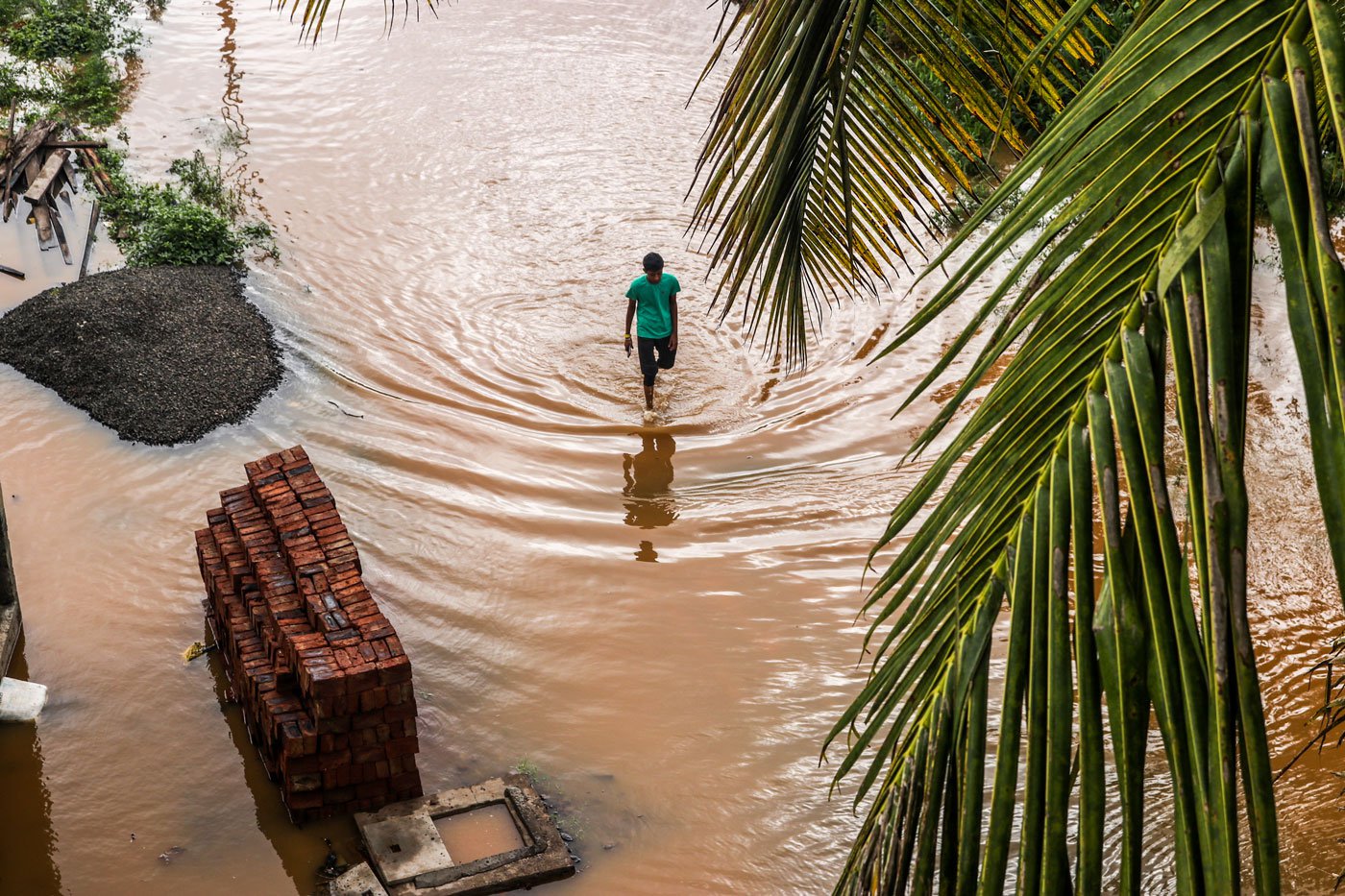
Shirol was one of the worst affected talukas in Kolhapur during the floods of 2019 and 2021
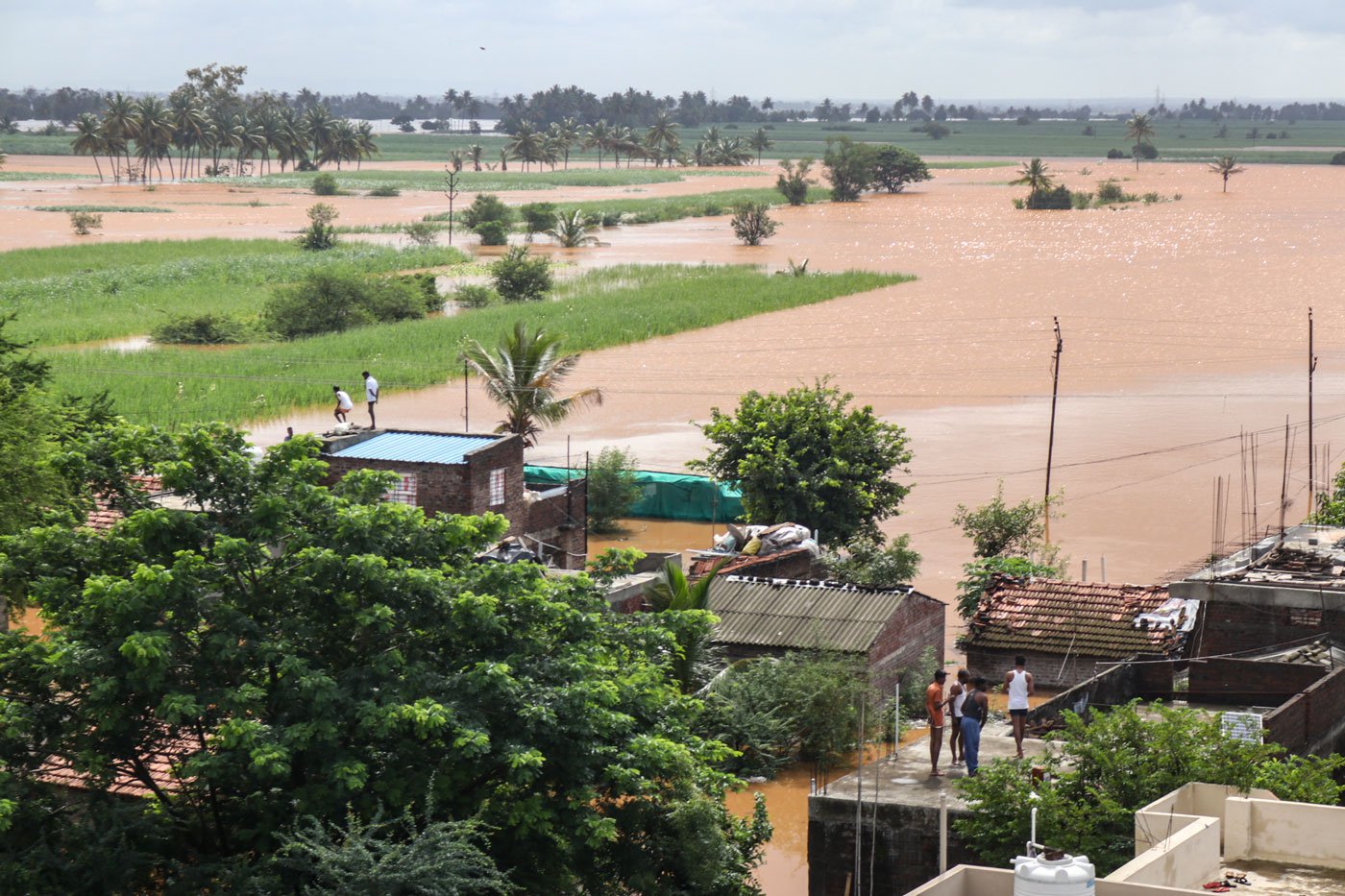
Flood water in the village of Udgaon in Kolhapur’s Shirol taluka . Incessant and heavy rains mean that the fields remain submerged and inaccessible for several days, making it impossible to carry out any work
National Family Health Survey findings point to a 72 per cent rise in hypertension cases amongst adult women (15-49 years) in Kolhapur district between 2015 and 2020. A study that assessed 171 people affected by the 2018 floods in Karnataka's Kodagu district found that 66.7 per cent had developed symptoms of depression, somatic disorders, substance abuse, sleep problems and anxiety.
Another
paper
found that 45.29 per cent of people affected by the December 2015 floods in Tamil Nadu’s Chennai and Cuddalore were diagnosed with psychiatric morbidity; as many as 101 individuals of the 223 surveyed were found to be depressed.
Vishal Chavan, who trains 30 Taekwondo students in Bhendavade, confirms noticing similar impacts on the mental health of young sportspeople. “Since 2019, many students have quit sports because of these conditions.” Aishwarya, who trains with him, is reconsidering her plans to pursue a career in athletics and martial arts.
Before the 2019 floods, Aishwarya had helped her family cultivate sugarcane on a four-acre field. “Within 24 hours, the floodwater entered the
usacha mulya
[vascular bundle of the cane] and completely destroyed the crop,” she says.
Her parents work as tenant farmers who must give 75 per cent of the produce to the landowner. “The government did not give any compensation in the 2019 and 2021 floods; even if there was any compensation, it would have gone to the landowner,” says her father, Raosaheb, 47.
With over 240,000 kilos of sugarcane worth Rs. 7.2 lakhs perishing in the 2019 floods alone, both Raosaheb and his wife, Sharada, 40, have been forced to double up as agricultural labourers. Often, Aishwarya pitches in and milks the family’s cattle twice a day. “At least for four months after a flood, you don’t get any work,” says Sharada. “This is because the fields don't drain quickly, and it takes time to restore the soil's nutrient quality.”
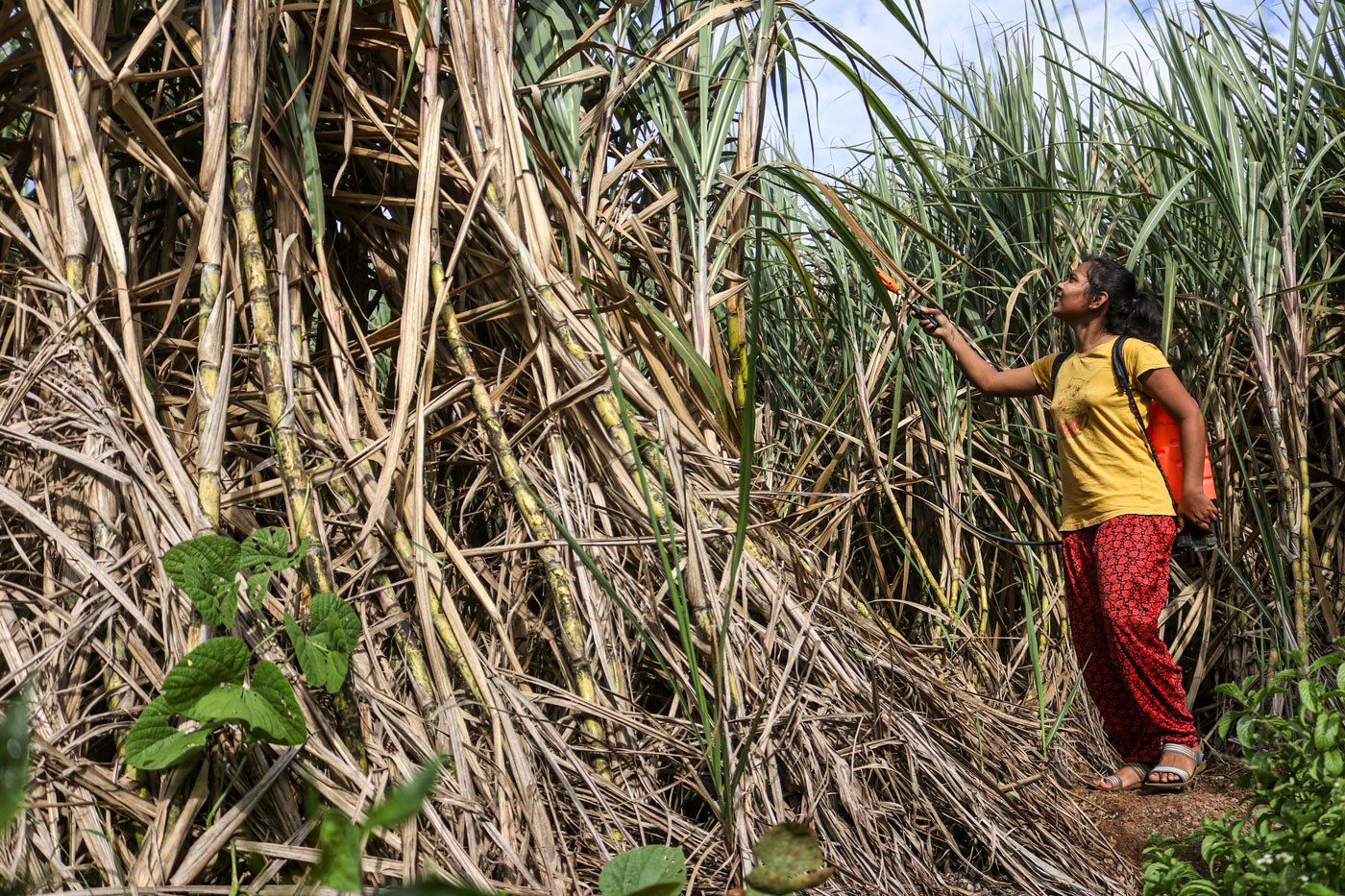
Aishwarya, who has to help her tenant-farmer parents on the fields as they struggle to stay afloat, is now considering giving up her plan of pursuing a career in sports
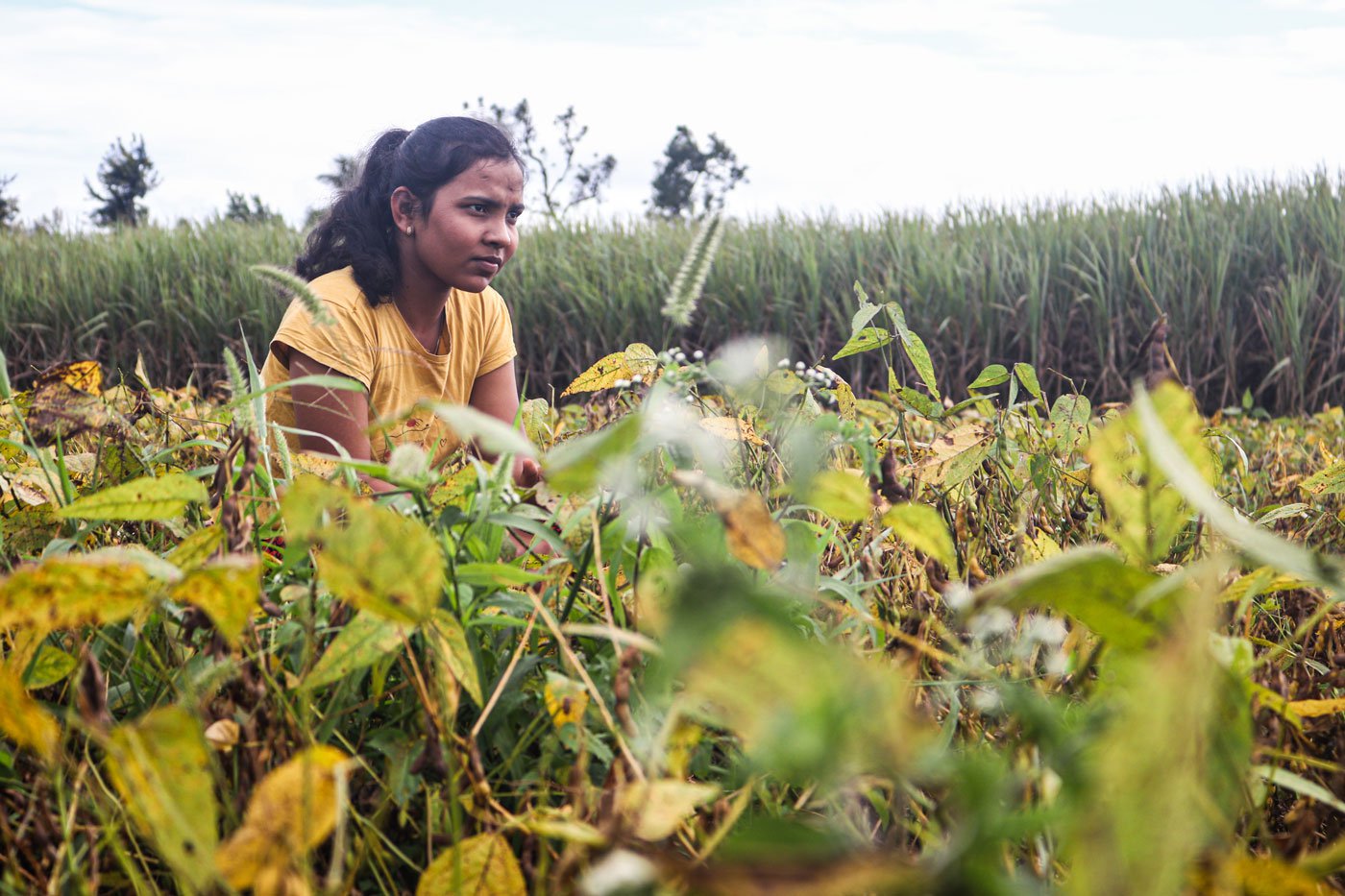
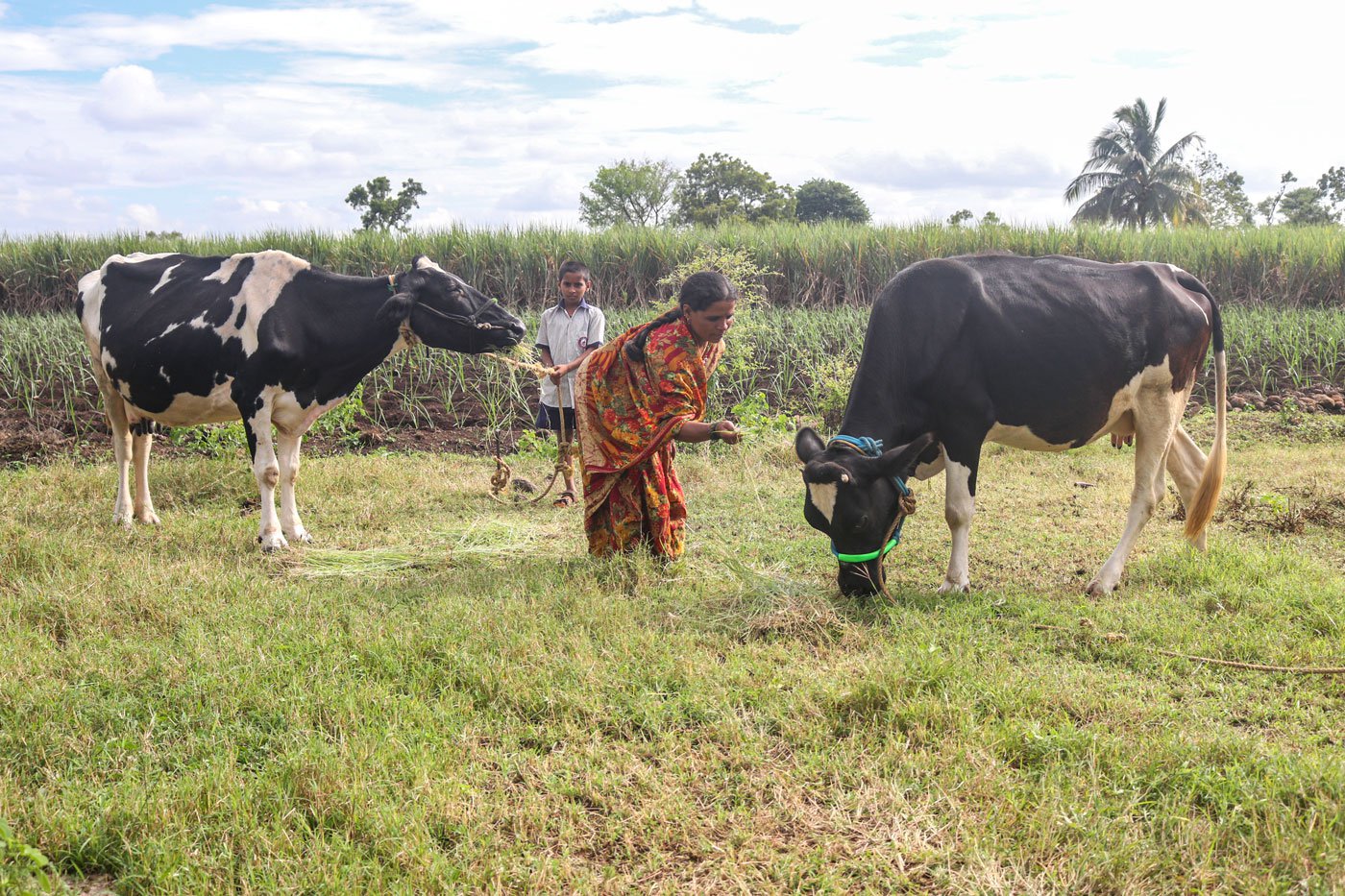
Left: Along with training for Taekwondo and focussing on her academics, Aishwarya spends several hours in the fields to help her family. Right: With the floods destroying over 240,000 kilos of sugarcane worth Rs 7.2 lakhs in 2019 alone, Aishwarya's parents Sharada and Raosaheb are forced to double up as agricultural labourers
Similarly, during the 2021 floods, Raosaheb lost over 600 kilos of soybean, worth Rs 42,000. Looking at such devastation, Aishwarya is unsure about a career in sports. “Now, I am considering applying for the police examination,” she says. “Relying on sports is quite risky, especially in this changing climate.”
“My training is directly linked with farming,” she adds. With farming – and, therefore, her family’s livelihood and survival – being at increased threat from climate change events, Aishwarya’s apprehension about a career in sports is understandable.
“During any [climate] disaster, women athletes are the worst affected,” says sports coach Pandurang Terase from Pethewadi village of Kolhapur's Ajra
taluka
. “Many families are not supportive, and when their daughters stop training even for a few days, the families ask them to quit sports and start earning, which erodes their mental health.”
Asked what can be done to help these young people, clinical psychologist Kakade says, “The first step can be what we do in systemic therapies or grief counselling – just listening and letting them talk about their feelings. When people get the platform to share their difficult emotions, they start feeling relaxed because they have a primary support group, which goes a long way in healing.” The truth, though, is that millions of Indians find it
difficult to access mental health care
because of under-resourced health care infrastructure and high treatment costs.
*****
Long-distance runner Sonali Kamble’s sporting ambitions hit a speed breaker after the floods of 2019. Her parents, both landless agricultural labourers, needed her help to keep the family afloat through the extended financial crisis that followed.
“Despite the three of us working, we can't make ends meet,” says her father, Rajendra. Incessant rains leave the fields inundated and inaccessible for long periods, causing a rapid decline in the number of working days and, therefore, in the income of families dependent on farm work.
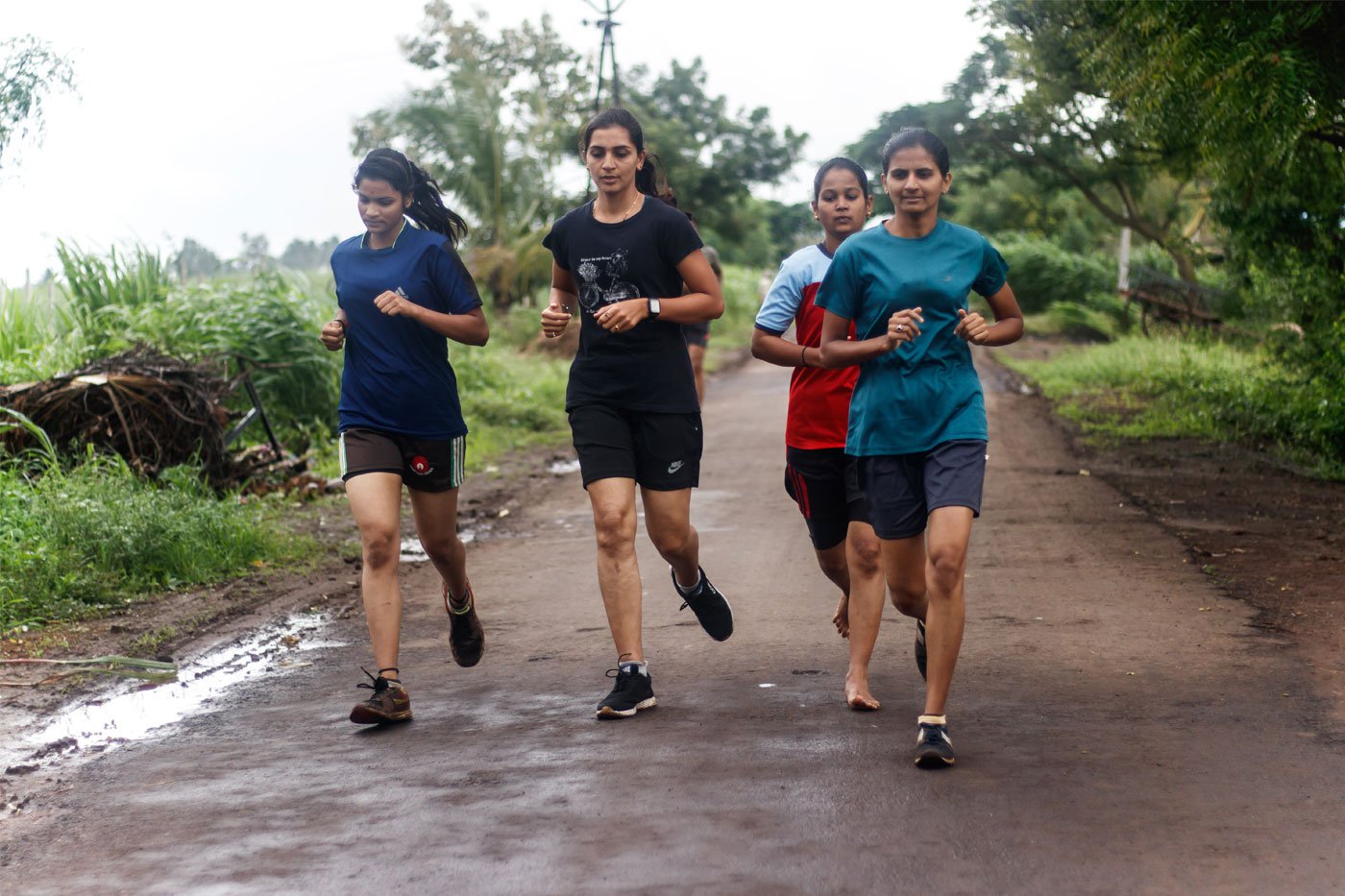
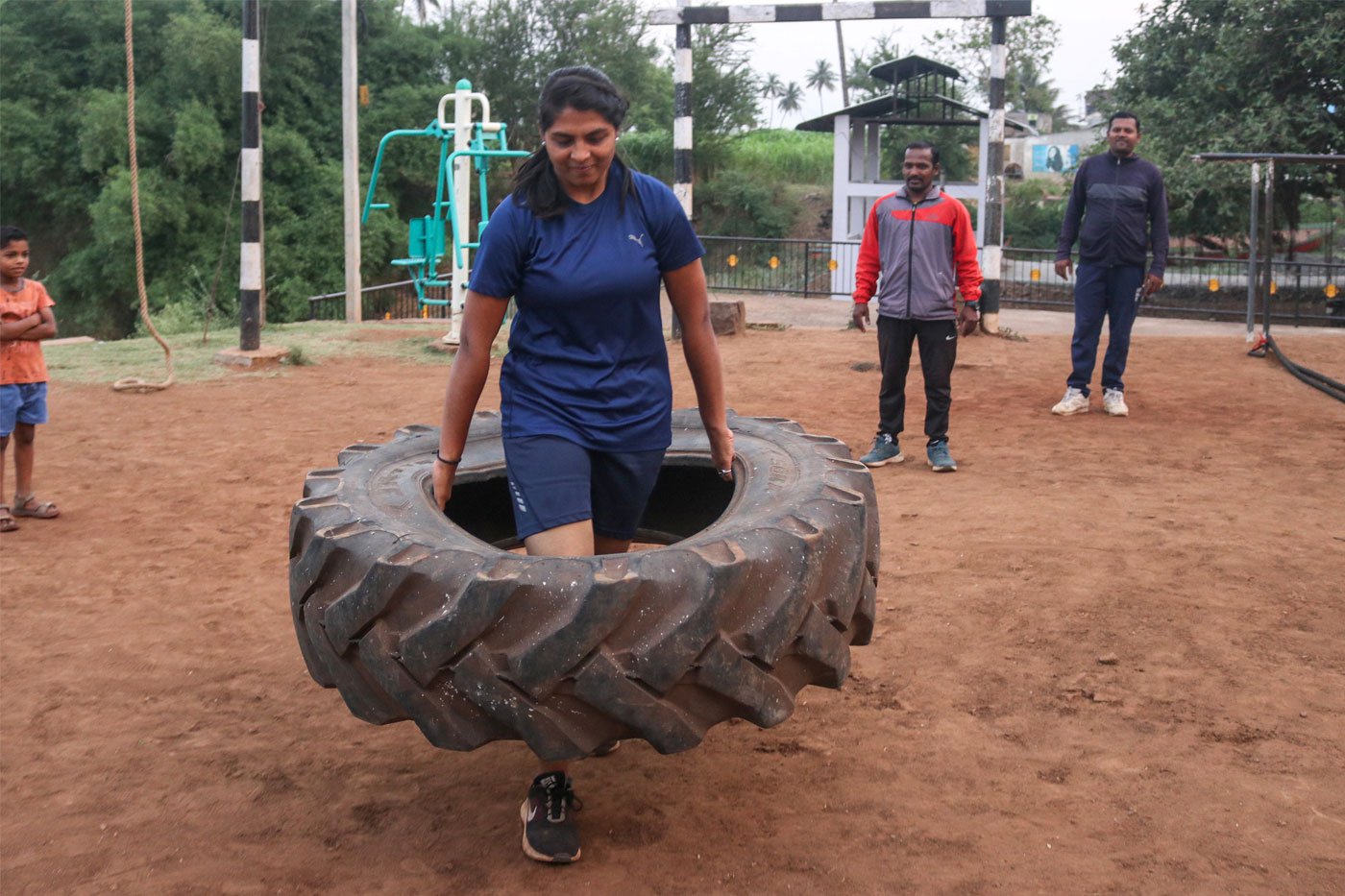
Left: Athletes running 10 kilometres as part of their training in Maharashtra’s flood-affected Ghalwad village. Right: An athlete carrying a 200-kilo tyre for her workout
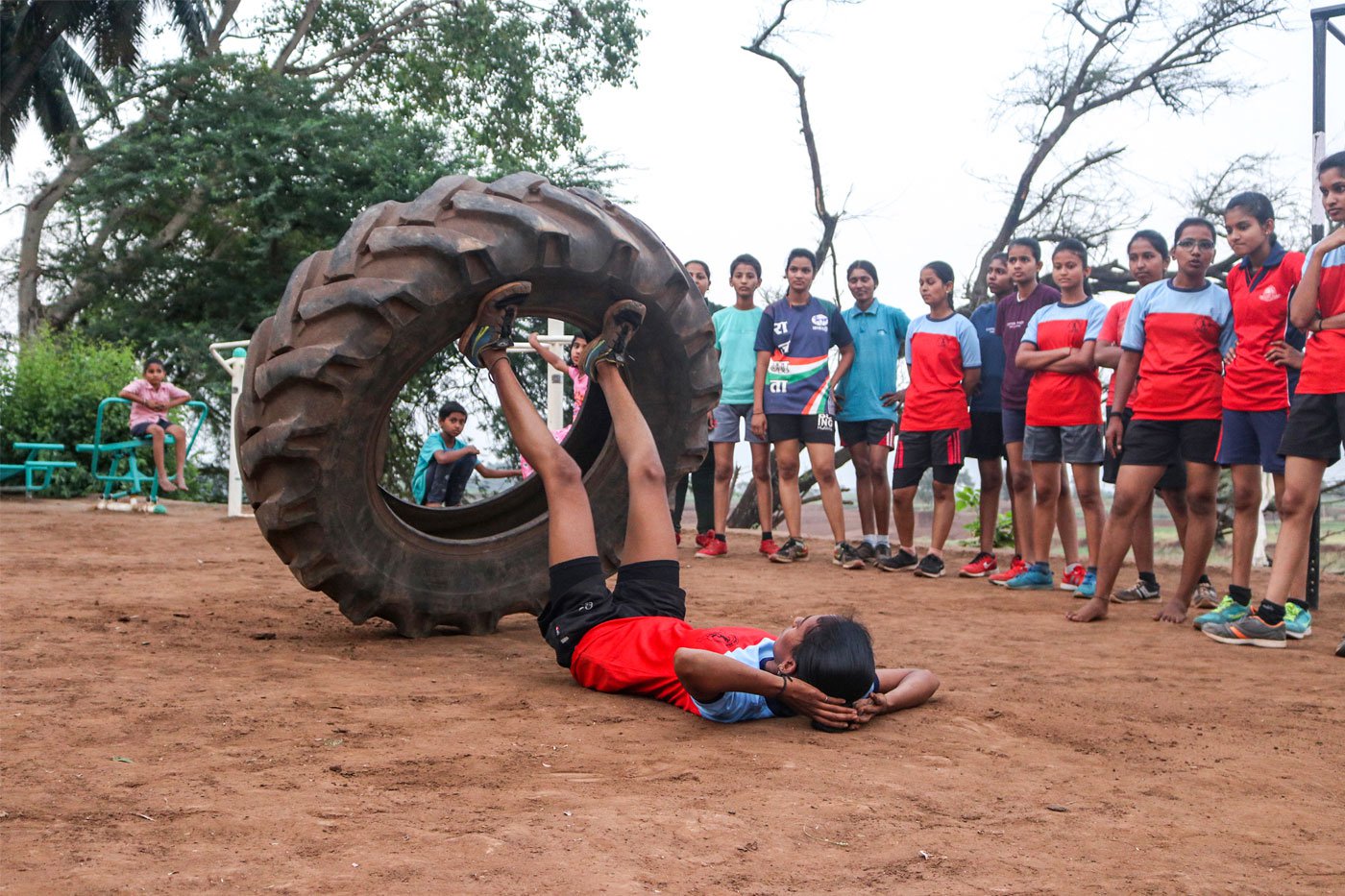
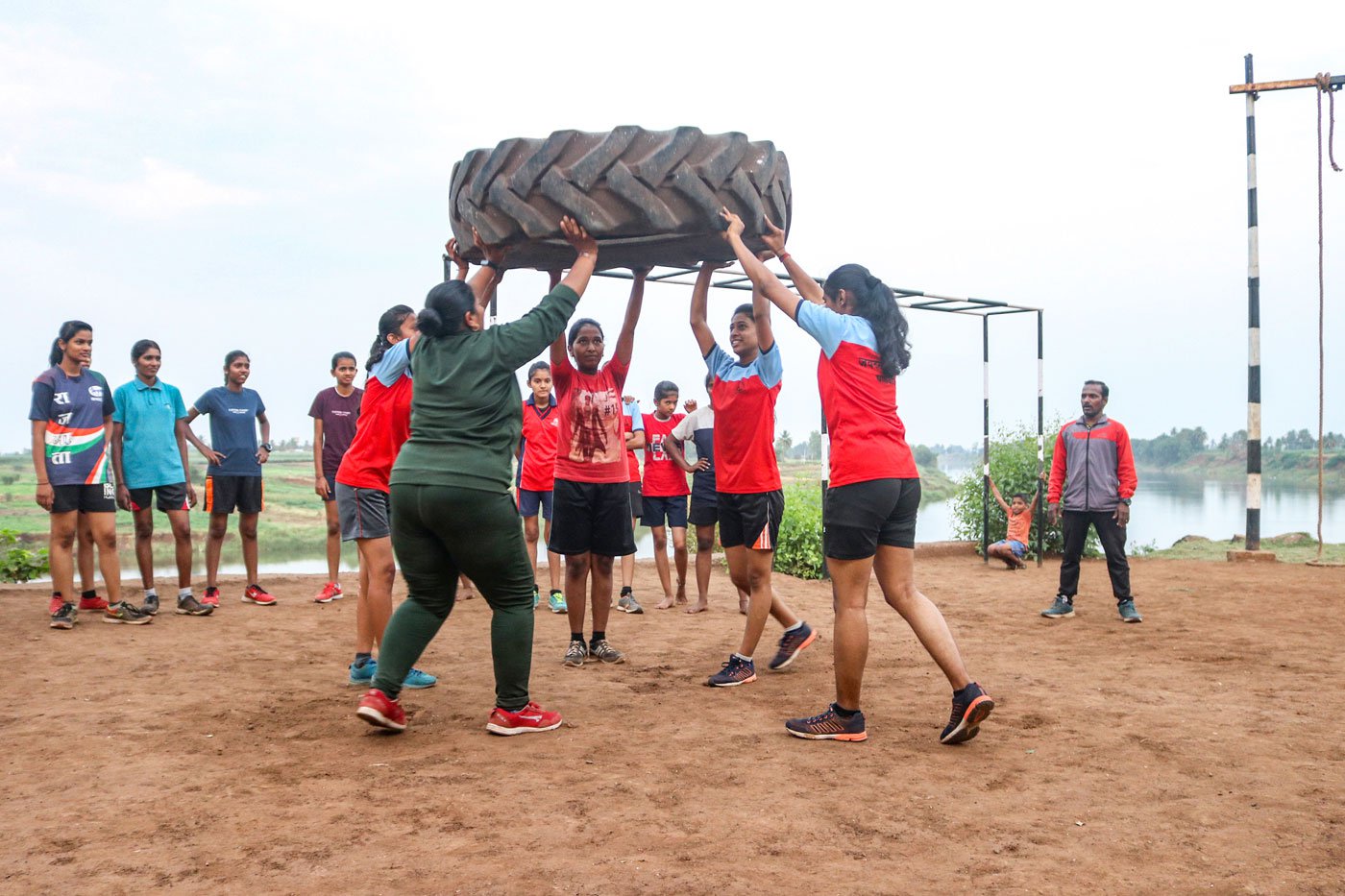
Athletes in Kolhapur's Ghalwad village working out to build their strength and endurance. Several ASHA workers in the region confirm that a growing number of young sportspersons are suffering from stress and anxiety related to frequent floods and heavy rains
In Ghalwad village, Shirol taluka , where the Kamble family lives, women earn around Rs. 200 for seven hours of work, while men are paid Rs. 250. “This is barely enough to run the family, leave alone buying sports equipment and paying for training,” says Sonali, 21.
The 2021 floods further added to the woes of the Kambles and pushed Sonali into deep mental distress. “In 2021, our house was submerged within just 24 hours,” she remembers. “We somehow escaped the flood water that year. But now whenever I see the water level rising, my body starts aching as I fear it will flood again.”
When it started raining heavily in July 2022, the villagers feared that the Krishna river would flood, says Sonali’s mother, Shubhangi. Sonali skipped her daily 150-minute training session and began preparing for the deluge. She soon started experiencing severe stress, leading to a visit to the doctor.
“When the water starts rising, many people are caught in a dilemma whether to shift out of their homes or not,” says Dr. Prasad. “Their inability to predict the situation and take a decision leads to stress.”
Although Sonali starts to feel better as soon as the water level recedes, “inconsistent training means I can't compete, which always stresses me.”
Many Accredited Social Health Activists (ASHAs) in Kolhapur’s villages confirm that the floods are causing anxiety amongst young local athletes. “They are helpless and frustrated, and it is getting worse with the changing rain patterns,” says Kalpana Kamlakar, an ASHA worker from Ghalwad.
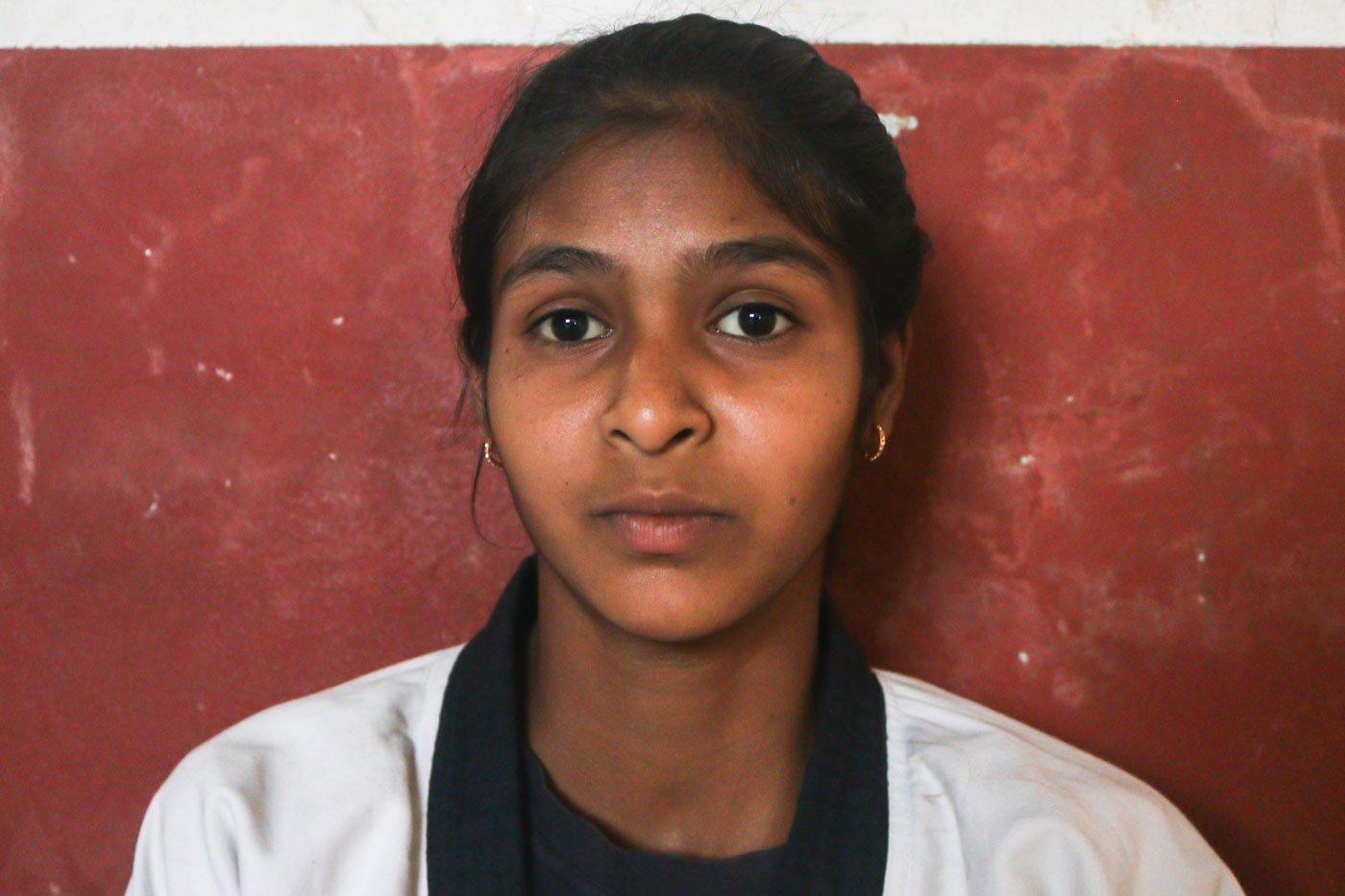
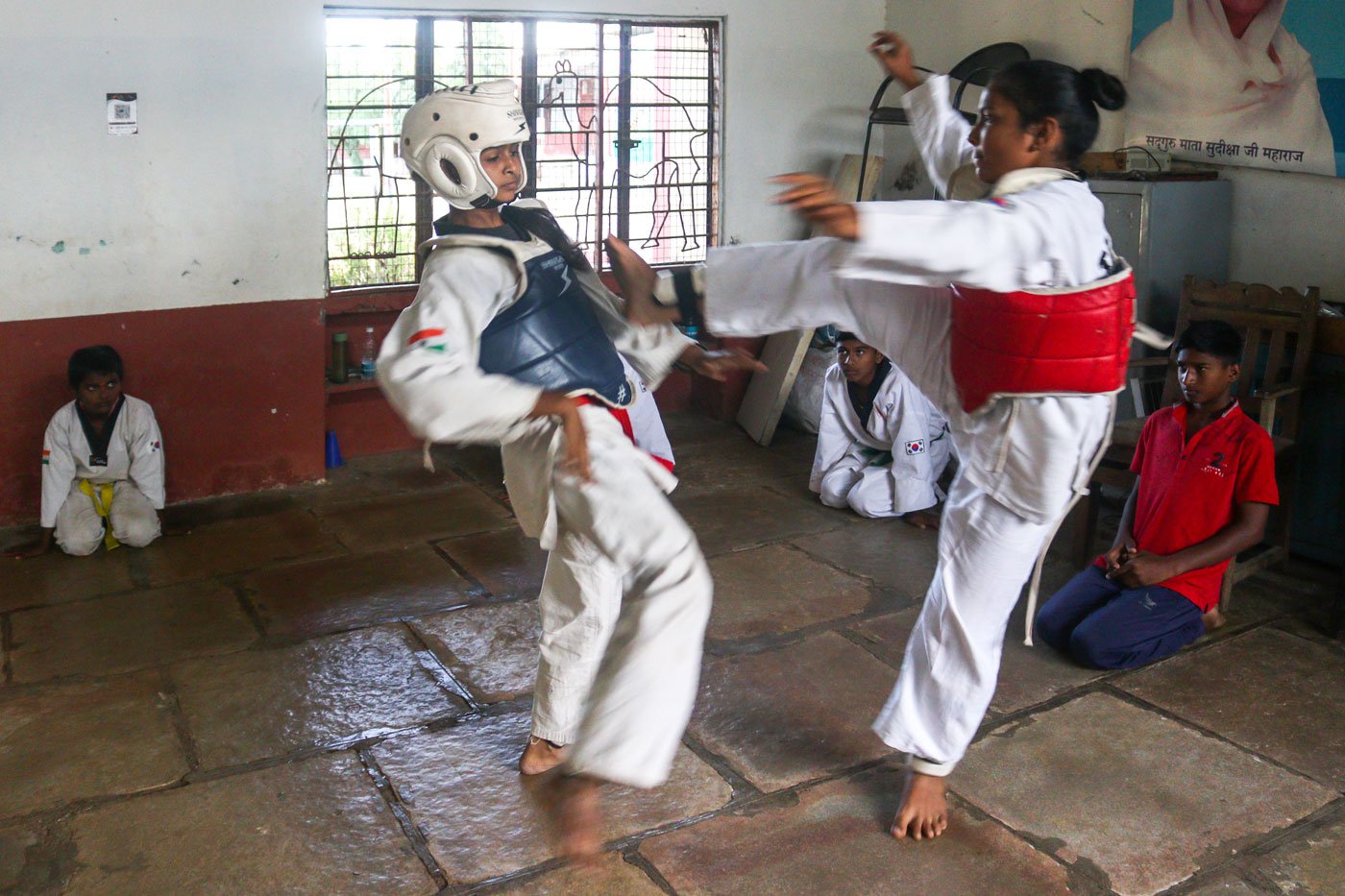
With the financial losses caused by the floods and her farmer father finding it difficult to find work, Saniya (left) often has no choice but to skip a meal or starve altogether. This has affected her fitness and performance as her body can no longer handle rigorous workouts
Aishwarya, Saniya and Sonali belong to agrarian families whose fortunes – or misfortunes – are closely linked to the rain. The families cultivated sugarcane in the summer of 2022.
Several parts of India saw a delay in monsoon this year. “Our crop survived even the delayed monsoon,” says Aishwarya, but the erratic monsoon rains, which began in July, completely devastated the crops, pushing the families deeper into debt. [Also read:
When it rains, it pours misery
]
Between 1953 and 2020, floods affected
2,200 million
Indians – roughly 6.5 times the population of the United States – translating into damages worth Rs. 437,150 crores. In the last two decades (2000-2019), India experienced an average of
17 flood events
every year, making it the world's worst flood-affected country after China.
For more than a decade, rainfall across many parts of Maharashtra has been increasingly erratic, especially in Kolhapur district. Just in October this year,
7.5 lakh hectares
in 22 districts of the state were affected by natural disasters. The area includes agricultural crops, fruit crops, and vegetables. According to the state's Department of Agriculture, in 2022, it rained 1,288 mm until October 28 in Maharashtra – 120.5 per cent of the average rainfall . And 1,068 mm of it was received between June and October.
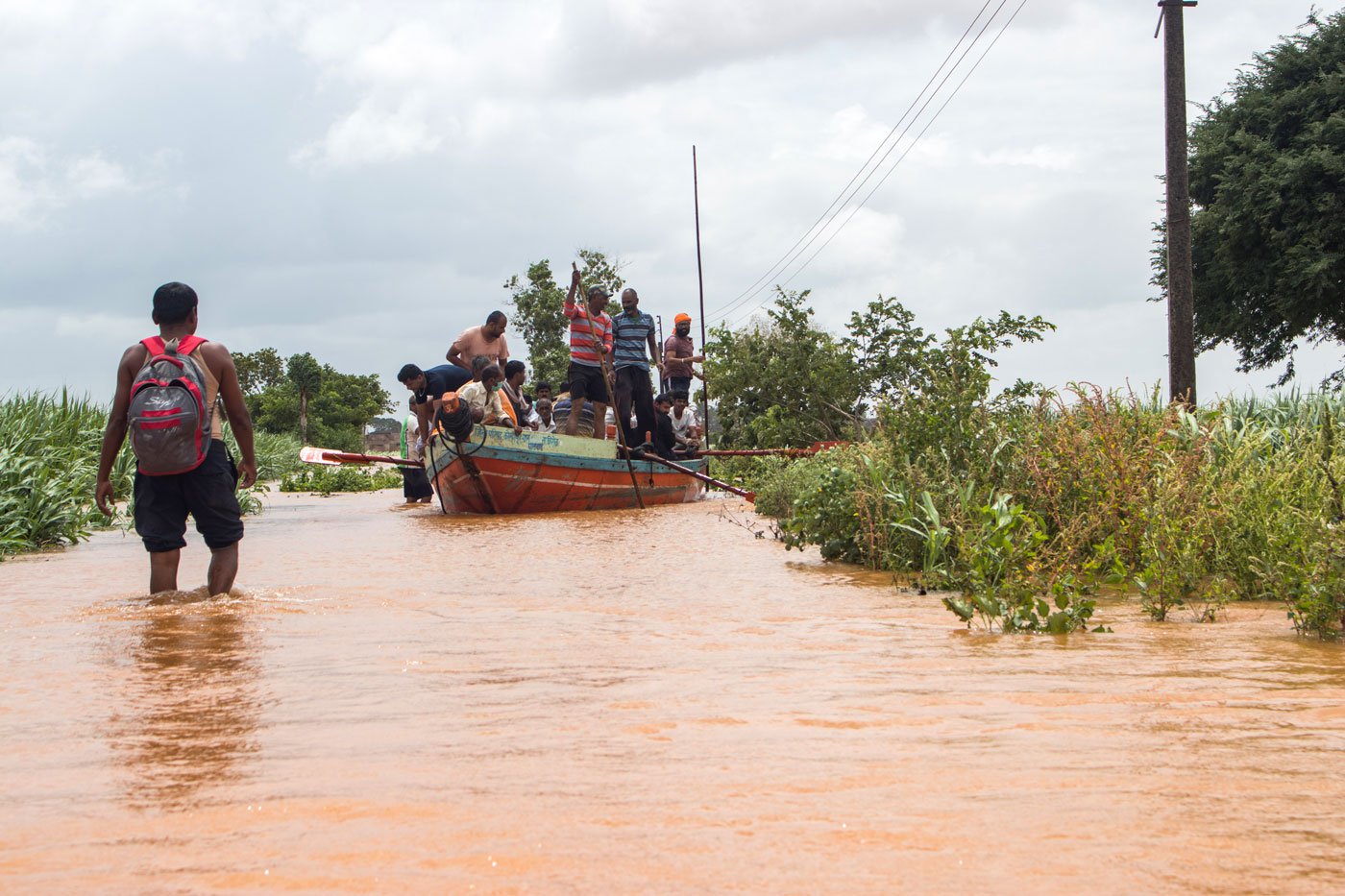
A villager watches rescue operations in Ghalwad village after the July 2021 floods
“During monsoon, we are witnessing longer dry periods interspersed with short spells of extremely heavy rains,” says Roxy Koll, a climate scientist at the Indian Institute of Tropical Meteorology, Pune, and a contributor to the IPCC report. “So, when it rains, a lot of moisture is dumped within a short period of time.” This leads to frequent cloudbursts and flash floods, he explains. “Since we are in the tropical area, climate events will get much more severe. So, we must be extremely careful and act quickly because we are the first to get affected.”
However, there is a major gap that needs addressing: the lack of adequate healthcare data that connects climate change with rising illnesses in the region. This leads to countless people affected by the climate crisis being denied visibility in public policies that are supposed to benefit the most vulnerable.
“My dream is to become an athlete,” says Sonali, “but when you are poor, you have limited options, and life doesn't let you choose one.” As the world plunges deeper into the climate crisis, rainfall patterns will keep changing and the choices available to Saniya, Aishwarya and Sonali will be tougher.
“I was born during the floods. I never thought I would have to spend my entire life in the floods,” says Saniya.
This story is part of a series supported by Internews’ Earth Journalism Network through an independent journalism grant to the reporter.
